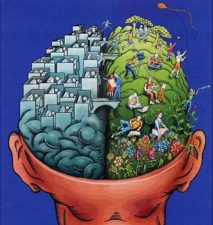I was listening to a talk radio show a couple weeks ago on my way to work and the caller was talking about the differences in visual spatial skills in men and women. He didn’t go into any depth but it was interesting enough that I made note and wanted to learn more. I read up from theorists such as Louis Leon Thurstone, Jean Piaget, and Howard Gardner. After reading many articles and scientific studies about visual spatial awareness, spatial acuity, spatial memory, and the like, it’s not clear to me that it’s an issue of gender, but of what type of learner the person is.

There are two ways that our brains attempt to organize information: visual-spatial and auditory- sequential. Let’s take a moment and think about what it means to have visual spatial preference. This is a holistic view or approach. People who lean to this type of thinking tend to see the big picture. They are able to pick out the finer details from that picture too in order to understand the whole. It is a non-linear way to think in which time may not restrict the idea or solution. These are the people who can come up with creative solutions to problems.
People who favor auditory- sequential learning will be the ones who need to know a timeline and then follow steps, in order, to get to the solution. They will use deductive reasoning to analyze the information they are given or that they collect. It is a highly structured way of looking at solutions. Most of us use a combination of these in order to solve problems each day. But, in order to get the truly innovative and revolutionary ideas, you will need to find someone who can lean to the visual-spacial side more.
Let me give you a personal example. When I was in the 4th grade, my class was put through testing to find out who could be part of the STRETCH class. This class was made up of 4th- 6th graders who would spend time each day exploring creative solutions to world problems. One of the test questions was to take a circle and add lines to make something. Most of my peers added lines to make the circle look like a clock. I added curvy lines on each side to make mine look like a lemon. I’m not sure if that was a “right” answer, but it helped get me into the STRETCH class. I’d like to think it was because I was able to see something that many of the other kids didn’t. They went with what was a more logical answer. I went with something more creative.
In the workplace, we’re given problems to solve and projects to lead. Can you imagine that the type of thinking the leader has will have a direct impact on your solution? It certainly will. And, the team that the leader puts together will also have a strong impact on the method used to find that solution in addition to contributing to the creativity (or lack of) of the solution. Think that through the next time you have a task or project to assign. Here are some questions to ask:
- What type of leader will you need on the project? Do they need to be more creative, or find a more traditional solution?
- What are the time constraints? If that is critical, you may need to choose someone who has a stronger auditory- sequential focus.
- Are you trying to “best” your competition? Choose a visual-spatial leader here because he/ she will think big picture and foster more creativity.
What type of learner are you? Are you a blend, or do you tend to lean one way or the other? Share in the comments because I’d like to see if you think that has an impact on the type of leader you are.
Oh, and if you want to try some fun games to test your ability on being a visual-spatial learner, check out Happy Neuron.
**Sharing this post from last year**

